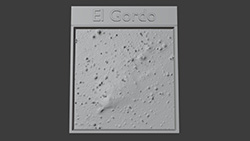CXC Home | Search | Help | Image Use Policy | Latest Images | Privacy | Accessibility | Glossary | Q&A
1
X-ray & Infrared Images of El GordoCredit: X-ray: NASA/CXC/Rutgers/J. Hughes et al.; Infrared: NASA/ESA/CSA, J.M. Diego (IFCA), B.Frye (Univ. of Arizona), P.Kamieneski, T.Carleton & R.Windhorst (ASU); Image processing: X-ray: L. Frattare; J. Major, K.Arcand (SAO). Infrared: A.Pagan (STScI), J.Summers (ASU), J.C.J.D'Silva (UWA), A.M.Koekemoer (STScI), A.Robotham (UWA), R.Windhorst (ASU)
Astronomers nicknamed this galaxy cluster “El Gordo” (Spanish for the “Fat One”) because it weighs up to 3 million billion times the mass of the Sun. These images show the diffuse, superheated gas in the cluster observed in X-rays from Chandra along with infrared data from Webb. The Webb image shows light from galaxies in the cluster and beyond it, including some that have been gravitational lensed by El Gordo’s mass, while Chandra and other observatories reveal that El Gordo is the most massive, and produces the most X-rays, of any known galaxy cluster at its distance or beyond
2
3D Printable Files: El Gordo (Composite Image)(3D Print Credit: NASA/CXC/A. Jubett, using software by Tactile Universe/N. Bonne & C. Krawczyk & Blender)
3D Printable Files: El Gordo (X-ray Only)
(3D Print Credit: NASA/CXC/A. Jubett, using software by Tactile Universe/N. Bonne & C. Krawczyk & Blender)
(3D Print Credit: NASA/CXC/A. Jubett, using software by Tactile Universe/N. Bonne & C. Krawczyk & Blender)
These tactile plates feature a field of distant galaxies and stars with a cone-shaped cloud at its core. The cloud is superheated gas in the galaxy cluster known as “El Gordo”, meaning “Fat One” in Spanish. The plates are depicted as physical relief maps based on the intensity of X-ray data captured by Chandra, as well as infrared data from Webb.
In each plate, the cloud has a cometary appearance, meaning it resembles a comet and its tail, with a raised tip that blends in as the cone-shape widens. Here, the raised tip is positioned near our lower left, with the fading conical shape widening toward our upper right. In the X-ray only plate, the conical area represents X-ray light observed by Chandra. The properties of the gas cloud suggest a multi-million mile an hour collision of two galaxy clusters. This collision produces more X-rays than any other galaxy cluster observed at its distance or beyond.
In the composite version of the plate with X-ray and infrared, throughout the gas cloud, and in the background, are thousands of distant galaxies and stars. Some resemble simple specks of light. Others are slightly larger and feature refraction spikes, or upon close inspection, discernible spiraling arms. Many of the distant galaxies behind the cluster appear distorted or elongated. The distortion is due to El Gordo’s great mass, which bends the light of these galaxies and distorts their apparent shapes.
In each plate, the cloud has a cometary appearance, meaning it resembles a comet and its tail, with a raised tip that blends in as the cone-shape widens. Here, the raised tip is positioned near our lower left, with the fading conical shape widening toward our upper right. In the X-ray only plate, the conical area represents X-ray light observed by Chandra. The properties of the gas cloud suggest a multi-million mile an hour collision of two galaxy clusters. This collision produces more X-rays than any other galaxy cluster observed at its distance or beyond.
In the composite version of the plate with X-ray and infrared, throughout the gas cloud, and in the background, are thousands of distant galaxies and stars. Some resemble simple specks of light. Others are slightly larger and feature refraction spikes, or upon close inspection, discernible spiraling arms. Many of the distant galaxies behind the cluster appear distorted or elongated. The distortion is due to El Gordo’s great mass, which bends the light of these galaxies and distorts their apparent shapes.
Return to: "El Gordo": A Galaxy Cluster That Pushes the Limits (August 2, 2023)






